





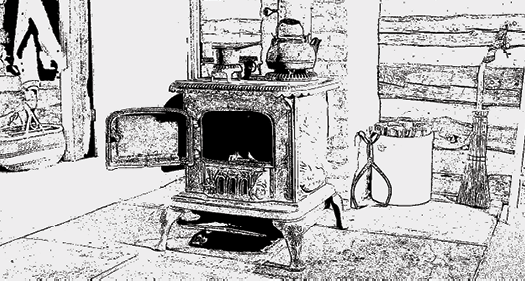
It stands there in the corner
Of the barn there on the floor.
It hasn’t any chimney
And it hasn’t any door.
The top is kind of rusty,
And with dust it’s covered o’er.
But it could tell you many tales
You’ve never heard before
It has seen a lot of living
In the happy days gone by.
It’s heard a family’s laughter,
And it’s heard a baby’s cry.
It’s heard the shouts of anger,
And it’s heard a lover’s sigh.
It’s kept a family happy,
For it kept us warm and dry.
The Old Wood Stove
The Old Wood Stove
By Phil Pothier
Oh, once its place was central,
In the middle of the room.
It’s friendly warmth dispelling
All the winter’s chilly gloom.
The family sat around it
In it’s cheerful cherry bloom
You could hear the red oak roaring
And the flames would crack and bloom.
But we use oil heat now a-days,
The wood pile is no more,
The chimney pipe is taken out;
We have a new tile floor.
And so the old stove’s day is gone,
It’s day of glory done.
Though I will miss the old wood stove,
It had a good long run.





OCTOBER
1949
By Clifton J. (Jerry) Noble Sr.
By age 23 I had acquired a driving li-cense, a job in the survey section of the Massachusetts Department of Public Works, a 1948 Crosley sedan, and a country school-house, without electricity or running wa-ter, which I had been able to remodel into a three-room-plus-attic home for my widowed mother and self. We moved in April 30th.
Mother, Minnie Emerson Noble, had been nicknamed “Hester” by me. She was 61. I had been keeping a journal for six years. Its pages give October happenings.

October 2009
Provincetown, 1949, photo by Clifton J. Noble Sr.
October 9, 1949 Sunday. Yesterday Un-cle Ralph Emerson came up. In about five minutes we had the last two-foot well tile in position. (Through the summer I had dug a ten-foot deep well on the 2 ½ acre lot across Herrick Road from our schoolhouse. I found water seven feet down. Five two-foot sec-tions of 24-inch-diameter tile lined the sides. A board top could be lifted to dip out water with a bucket, and eventually supported a hand pump.)
Percy Helms, who lives a mile north up Carrington Road brought us two cords of firewood today. He said the ruined Pickett house on Pomeroy Road at the end of Shat-terack Pond has been sold. (The pond has a floating island.)
October 13, 1949 Thursday. (1:00 a.m.) Yesterday had grand weather for a holiday. I dug a hole across the road and cleaned our outhouse—two wheelbarrows (lined with newspaper) full. The quicklime we’ve been using made things dry and almost odorless. I washed the shovel and took a bath in the brook.
The old timber bridge over Bear Den Brook one tenth mile south of the house has been removed. The crane left last night. Four men are building forms for high con-crete footings to support a new metal arch. I haven’t liked the idea of being without a bridge. A strong north west wind all day makes me think what might happen if a for-est fire got started. Mount Tekoa was burn-ing tonight when we passed it on the way home. The Russell telephone operator said the fire started about four o’clock. There is
The morning of September 29 my Cros-ley gave out on me. I asked my survey par-ty chief, Louis Johnson, for the day off and went to see what could be done. To repair the Crosley would take too long so I left it for Charlie’s Gas Station to sell and bought a ’37 Plymouth from Leader Chevrolet. Right away I replaced battery and connections, starter switch, changed oil and filter, flushed radiator and got it lubricated so it is in better condition that when I bought it.
Today we had a visit from Mr. Phillips who sold me the Plymouth. He now works for Holcombs in Westfield. With the bridge out and road closed he had to park across the brook and walk so was puffing when he arrived. He said a new Plymouth 2-door se-dan had come in and the party who ordered didn’t want it. Were we interested? We were.
We went to Holcombs at four. We prayed that if the car were not for us it would be sold. We made a down payment of $100. It is black and more streamlined than most 1949 Plymouths. Its price is $1,700, but Mr. Hol-comb is allowing us $250 on our 1937 which is five dollars more than I paid for it two weeks ago.
October 16, 1949, Sunday. On the way home Friday I picked up groceries from the First National. Then I went to Holcombs to get our new Plymouth. What a difference from other cars I’ve had—smooth, silent, powerful. Hester was waiting at 99 Court Street. Hester, an angel in her yellow dress, invited Aunt Florence Boyce to have the first ride in the new car when we went down to get the milk that I had forgotten..
Saturday morning I graded the driveway after bumping bottom when I drove in Fri-day night. We had company at noon. Early evening we visited Evelyn and Alan Beck-ett on Whitney Avenue in Holyoke. Evelyn is related through the Allyns. Alan asked if I would do the favor of reading one or two of his stories. When I told him I though his stories were of Atlantic Monthly and Harp-ers quality, he said those were magazines his
agent was trying to sell to and that one had sold for $700.
October 19, 1949, Wednesday (1:00 a.m.) There had been a display of aurora borealis (northern lights) Saturday evening. Short-wave radio programs from Europe didn’t come in at all. I have been reading Sunspots in Action by Harlan True Stetson, how au-rora borealis is thought to result from sun-spots.
Sunday morning I walked up the aban-doned road to the Brant lot where Mrs. Helms keeps her cows. Along the road on the north side of that pasture are four old cellar holes with crumbling stone chimneys.
Monday morning Hester got me up at 5:30. She was going to Westfield with me but we didn’t have to leave till 7:45. I woke with a headache that was ripping by evening. A good night’s sleep cleared it.
October 22, 1949 Saturday. Some of the District 2 survey parties are being sent to the Boston area to work. This morning we went
round through Huntington to Westfield. We stopped at Rivards for my saw which Louis had sharpened and set for 75 cents. I bought antifreeze and a new shirt. On the way home we came over Montgomery mountain and stopped to see the Allyns. Town Clerk Wal-ter was our cutting brush. His wife Maud’s garden is still a profusion of flowers. The wind is blustery but not cold so I can still wear shorts.
October 29, 1949, Saturday. Last week, as transit man, I went with party chief Louis Johnson and rodman Ernie Rapisarda to work in Truro on the Cape. It was suggested that we stay at the Anchor and Ark in Prov-incetown. The District Supervisor, Robert Broomhead, says there is even work on Nan-tucket Island. Every morning I got up early enough to take long walks up Commercial Street, out the long wharf or up past the


tower. Food prices are high and only about three restaurants are operating. The library is small, old, incomplete, but with pleasant assistants. The only art display was a win-dow of good watercolors by the Five Pfief-fers. A mongrel dog waits on the top step of the Historical Museum between seven and eight. Everything’s closed from the “Lobster Pot” to the Provincetown Inn, and the Bos-ton boat stopped running September 6.
We have had the new Plymouth in for its 1,000-mile check up, Next week I plan to drive to the Cape to meet Louis and Ernie and the survey carryall. Hester will go along to revisit Provincetown. We are so thankful to have a good car and our own home in the mountains.
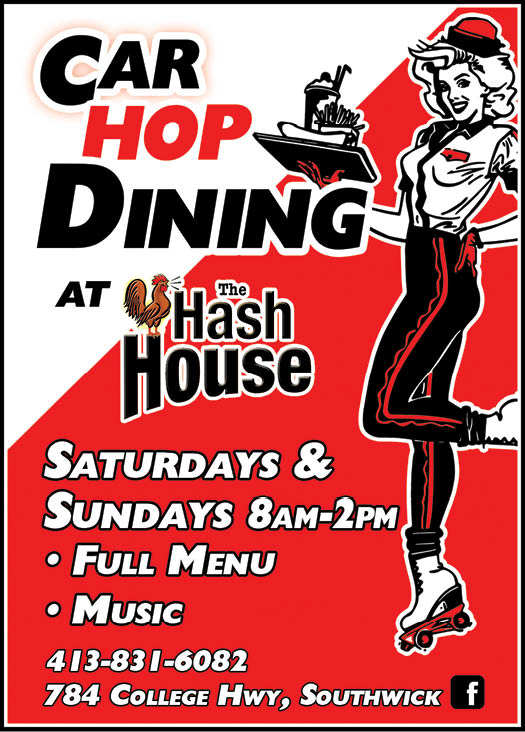


not much danger of its traveling four miles up this way. Clear as the day has been a dark bank of clouds blew in with the northwest wind. At home I went out and prayed for rain more fervently than I thought I could. I thanked God for taking care of his forests and all those who love to live in them. While I stood there drops began to fall. Showers continued all evening and now the woods are wet enough to be out of danger.
Our stopping tonight was the first time Ethel Helms has met Hester. She invited her to visit and offered a ride with the oxen. All Mrs. Helms’ cattle look as though someone loved them.





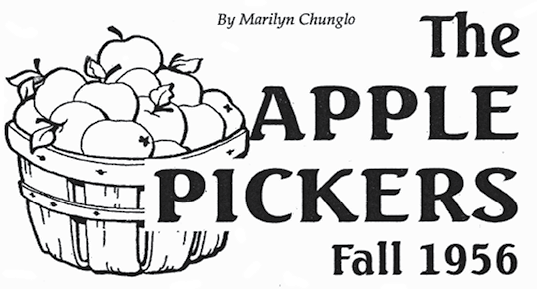
The Neighborhood was quiet. No children’s voices calling to each other or merry laughter. No joyous barking from the dogs as they chased an errant ball. The yellow school bus has long gone taking the children with suntanned skin and sun bleached hair, scrubbed and in their new too large clothes, off to the first day back to school. Some of the children went with regret, leaving the carefree hours behind, while others went with excised anticipation to see old friends and meet the new learning challenges that awaited them.
The blue cloudless sky added to the tranquility of the day as mothers hung the too small summer clothes, probably for the last time, on the clothes lines. Crickets chirped merrily in the long dry grass surrounding the short green grass of the lawn. The last of the Queen Anne’s Lace, spindly, falling over was being replaced by the goldenrod. Grasshoppers leaped first one way then another not knowing where they were going or why.

November 1998
The phone rang breaking the silence of the day.
“Hello.”
“Hi, what cha doin?” said the voice coming from the other end of the line.
“The usual.” I answered.
“Back to normal, huh? Depressing isn’t it?”
“I heard Ed Jensen’s migrant workers aren’t coming to pick apples. He’s desperate. Interested?”
“Sure, why not.” I answered.
“I’ll pick you up tomorrow after the school bus leaves. Pack a lunch, wear boots, it will be wet in the morning but bring shoes. It will be too hot to wear boots after the grass dries off. See ya.”

The next morning things were popping, getting everyone off, doing dishes, making beds, packing a lunch and gathering boots and shoes. Sure enough, shortly after the bus left I heard a toot in the driveway. I hurriedly gathered my things and ran out to the car.
It was a lovely drive up to Granville following the winding road through the Gorge. We turned right at the Old Westfield Road and rode north to Ed Jensen’s farm. There was already a group of people picking apples in the south orchard. We put on our boots and trudged through the wet grass to where the pickers were.
We were greeted by an elderly gentleman dressed in bib overalls. “Can I help you?” he asked as he approached us.
“We heard you needed pickers.” I said.
“Are you experienced?”
“Do you care?” I asked
He laughed. “Not really. I’m grateful for all the help I can get.”
“We have school children,” I said, “but if you are willing to take us on after we get the kids off to school and if we leave in time to be home before the bus comes back in the afternoon, we are willing to work.”
Mr. Jensen smiled and shook his head. “It sounds good to me. Can you climb ladders?”
Sheila grinned. “Sure piece of cake.”
Mr. Jensen showed us how he wanted the apples picked, gave each of us a basket and left us. Stella, the girl in charge came over and introduced herself. She told us to pick what we could reach from the ground to start with and then we would work our way up.
We hadn’t worked too long when Stella called for coffee break. The others had been there since 7 am. Everyone retrieved paper bags from a pile by a tree. We sat on the ground in a cluster. We were introduced to the Granville crew. It didn’t take long before we were all chatting like old friends, sharing cookies and recipes. There was teasing, joking and laughing. The coffee break had broken the ice. When we went back to picking the chatter continued, hands and tongues flying. It certainly wasn’t what one would call “work”.
We had our lunch break, then back to work. The afternoon flew by. It was time to leave, we gathered our belongings and walked down through the orchard to the hot cars. On the way home the breeze through the open


windows cooled the heat of the car. Relaxed, it was then however, that we noticed the aching of our arms.
The next morning we were ready to go again.
“Are you ready for this?” asked Sheila as I got into the car.
“Why are your arms sore?” I asked.
“Sore, gee.”
“We’ll work it out picking again.”
“That’s what John said.”
A few days later after we arrived we met Mr. Jensen again “Are you ready to climb today?” he asked.
“Yes, yes,” I said, “I’d love to climb.”
“Go see Stella. George will move the ladders. I don’t want the girls to do it. The ladders are too heavy.”
Off we went to find Stella. I went up the ladder with my basket. Hung it on the top rung of the ladder and started picking. It was fun leaning out as far as I dared. I felt like an aerial artist defying gravity. My basket was full. I called the carrier. While waiting for another empty basket I laid against the rungs and looked off into the distance. I could see all the way to Tekoa Mountain. What a beautiful vista. I was so entranced I forgot what I was there for, I guess.
“Hey, wake up, up there. You want your empty?”
“Yes, thank you. Gee, what a beautiful view.”
“You’re not here to look at the view.” growled George.
“No heart no soul.” I grumbled.
“Your right. Remember that George.” someone called.
“I’m here to see the job gets done.”
“Okay, George, we’re back to work.”
It was a glorious fall. The company, the fresh air, the sunshine, the exercise. Physically, we felt fit. Mentally, there had been no stress. The aroma of the apples was as delicious as the apples themselves. We even had extra money that we could put aside for Christmas spending. It had been a wonderful experience, thanks to the migrant workers that had never shown up.





Dec 1996

Part 2
By Elethea Goodkin
At that time , the waters of the North Pond came up farther toward the house and road than they do now, she says. Directly behind the house, going toward the pond, were a se-ries of buildings including a garage and tool shed, the old ice house, a barn and cider mill, and a little boat house right near the pond.
Mary says that during the day, the water had risen in North Pond, and it was up to the barns. That night her mother, Rose Keenan, noticed a thin sheet of water from the pond hydroplaning over South Longyard Road, and the yard was getting soggy.
Her mother called the Highway Depart-ment and told them of the problem. Accord-ing to the Bicentennial account, the highway crew rushed to the North Lake dike and worked for two hours sandbagging to keep the lake from going out, but they were un-able to stop it from overflowing.
Mary remembers that sandbagging was going on during that day at Middle Pond to keep it from overflowing, but no one had worried about North Pond, she says, because its waters flowed south into Middle Pond (where the outlet was).
Mary said the men helped her family move all their furniture to the second floor of the house to save it, if the waters rose. Only the sofa, stove, and refrigerator were too heavy to move upstairs, so these were stored at a neighbor’s house up the hill toward town.

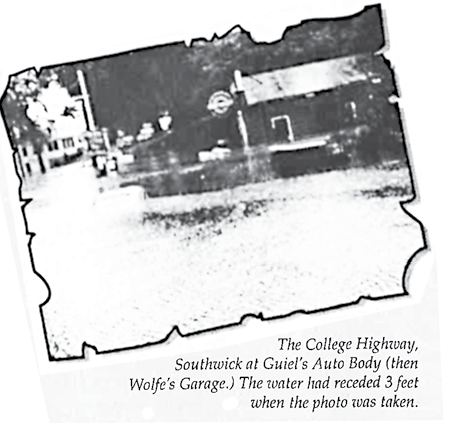




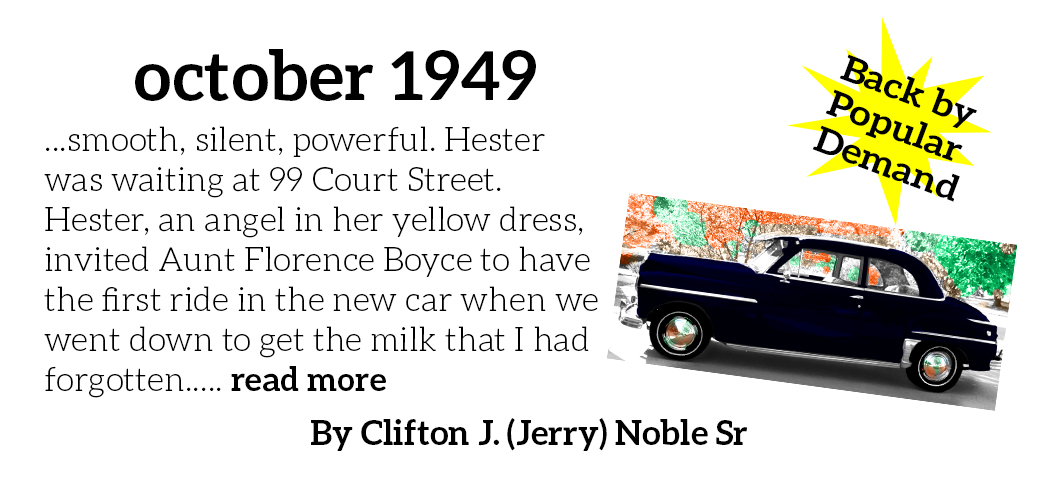









Well, it sounds like that old fellow wasn’t too good to his wife. Let me ask you a question: Are you good to people? Are you kind and considerate? Do you speak and act with good intentions?
Here’s something I want you to know: How you treat other people can have a direct impact on the degree of blessings you’re experiencing in your life. Friend, you can’t treat people poorly and expect to be blessed. You can’t be rude and inconsiderate and expect God to bless that behavior. Let me show you how you can better yourself by treating others better.
First, aim for kindness.
I heard about a couple who went on vacation to the Holy Land. While they were there, the cantankerous old husband passed away. The undertaker told the wife, “You can have him shipped home for $10,000, or you can bury him here in the Holy Land for $100.”
The woman thought about it and said, “I’ll have him shipped home.”
The undertake asked, “Why would you spend $10,000 to ship your husband home, when it would be wonderful to bury him here and you would only spend $100?”
The woman replied, “Look, long ago, a man died here in the Holy Land. He was buried here and three days later he rose from the dead. I just can’t take that chance.”
Finding Handfuls
of Blessings



The Bible says, “Aim to show kindness and seek to do good to one another.” Circle two words in that sentence: aim and seek. It’s saying we’ve got to be proactive. We’ve always got to be on the lookout – on the lookout for ways to share His kindness and goodness with people. We’ve got to aim for kindness and seek to do good. On top of that, we need to be kind to people even when they don’t deserve it. We need to be courteous even when somebody is unkind to us.
• When that coworker walks by you and doesn’t give you the time of day, God expects you to go the extra mile and be friendly to her anyway.
• If you’re on the phone and somebody speaks harshly to you, it’s easy to think, I’ll just tell her off and then hang up. She doesn’t even know me. She’s never going to see me. But God expects you to be bigger and better than that.
• When that cashier at the grocery store jumps down your throat for no reason, your initial response may be to act rudely in return. That’s the easy way; anybody can do that. But God wants you to live by a higher standard. Aim for kindness.
Do you know what? Everybody’s entitled to have a bad day once in a while. We’ve got to give people room to have a bad day! After all, you don’t know what that person is going through. That person’s child may be in the hospital. Her husband may have just walked out, and she’s having the worst day of her life. Keep taking the high road and be kind and courteous. God sees what you’re doing. If you’ll keep doing the right thing, you will come out far ahead of where you would have been had you fought fire with fire.
“Someone once helped me out, the way I’m helping you. If you really want to pay me back, here’s what you do: Don’t let the chain of kindness end with you.”




Application: Intentionally, proactively, and consistently demonstrate kindness.
Next, be on the lookout for people you can bless.
Joe was driving home one night in his beat-up, old car. He almost didn’t see the old woman, stranded on the side of the road. But even in the dim light of evening, he could see she needed help. All she had was a flat tire, but that was enough. Joe pulled over and said, “I’m here to help, ma’am. My name is Joe. I’ll fix that for you.”
She said she was from Saint Louis and just passing through. “I can’t thank you enough,” she said. Joe said it was nothing. He got to work and soon the car was as good as new. She asked, “How much do I owe you?”

In the autumn, as a result of cooler weather and shorter days, the food manufacturing process is slowed down. This results in a chemical breakdown of the chlorophyll, so that the starches and other foods go into the branches, limbs and trunks to be stored for spring use. When the green chlorophyll breaks down in the process, it becomes colorless, permitting the colors already present in the leaves to reveal themselves.
Two general classes of chemicals bring about the coloring of the leaves. One of these, carotenoids, is responsible for the yellows. Though present in all leaves, they only show up when the chlorophyll breaks down in the fall. When carotenoids are present without any other pigments, they cause foliage to turn yellow or orange, like birch or sassafras. A second class of chemical compounds, anthocyanins, is responsible for the reds and purples.


By Carol Leonard
The cool, brisk wind rustles through the rusty colored oak leaves. Yellow and red maple leaves cascade to the ground, where bushy tailed squirrels gather acorns. Neighbors are raking “mountains” of multihued leaves (as the children jump into them). It’s autumn in New England, a kind of living postcard.
What exactly causes this colorful miracle of nature?
During the summer, leaves are busy manufacturing food. This food, sugar, starches, and proteins is distributed by chlorophyll, the green coloring matter in leaves. When the chlorophyll captures the rays of the sun, it transforms carbon dioxide in the air and water in the soil into food which is distributed to the various parts of the plant.
The Mystery
of Fall Color
The Mystery
of Fall Color

October 1987

But Joe … Joe never thought twice about the money. This was not a job to him. This was helping someone. This was just his way of being a blessing to someone. He said, “Ma’am, I’ll tell you what. If you really want to pay me back, the next time you see somebody who needs help, give that person the help they need.” Joe added: “And think of me.”
The old woman thanked him and drove away. A few miles down the road, the old woman saw a little diner and decided to grab a bite to eat.
The waitress came over and the old woman noticed that she was about eight months pregnant. Though she was courteous as could be, the old woman could see the strain on her face and tiredness in her body. Then she remembered Joe.
So, when the old woman finished her meal, she decided to so something incredibly generous. She left that waitress a thousand-dollar tip and slipped out the door. When the waitress returned, there were tears in her eyes when she saw that tip. There was a note written on the napkin. It said, “Someone once helped me out, the way I’m helping you. If you really want to pay me back, here’s what you do: Don’t let the chain of kindness end with you.”
Well, there were tables to clear, sugar bowls to fill, and people to serve, but the waitress made it through another long day. That night when she got home from work and climbed into bed, she was thinking about the money and what the lady had written. How could the old woman have known how much she and her husband needed it? With the baby due next month, it was going to be hard. She knew how worried her husband was, and as he lay sleeping next to her, she put her arms around him, gave him a soft kiss, and whispered soft and low, “Everything’s going to be alright. I love you, Joe.”
Aim for kindness … Be on the lookout for people you can bless … And I tell you this: when you’re generous with others, God will be generous with you. It is, after all, what Jesus taught us: “Give and it will be given to you; Your gift will return to you in full measure … Whatever measure you use – large or small – will be used to measure what is given back to you.” You may be like Joe. You may not have a lot of extra money. But this is a matter of attitude. A lot of people say, “God, when are you going to bless me?” But if we’d listen more carefully, maybe we’d hear God saying, “When are you going to start being a blessing?”
Application: Have an attitude that says, “How can I become a blessing to someone today?”
even during summer, red maples and other trees will often display branches of vivid red and orange.
Equally fascinating is the manner in which the individual leaves fall. Actually, they do not drop off, at the point of detachment, a double layer of cells forms, finally cutting off the flow of sap. Then only a scar remains, rather than many open wounds through which pests and diseases might enter to cause illness and decay.
The trees most renowned for their bright apparel are basically the native ones. The red or “swamp” maple, one of the first to turn red, scarlet, orange or yellow is joined by the sugar or hard maple, along with the birch. If these trees were to be eliminated from the American landscape a great portion of the color display would be lost.
As a group, oaks are a rugged, colorful tree. They present light and dark red, dull gold, russet, wine and mahogany, turning to soft brown at the end of the season. For oaks, the end of the season can come even
Though starches and other foods are stored in limbs and trunks during the winter, some remain in the leaves where they combine with other substances in the fall to produce the bright colors we know - the reds, scarlets and purples, not to mention yellows. On warm, sunny days with temperatures in the seventies, starches and sugars become trapped if the mercury plunges quickly in the early evening.
On the other hand, if the autumn is wet and cloudy, little food is manufactured. If such days are followed by moist, warm evenings, there are no sugars and starches to be caught in the leaves. Contrary to popular belief, frost along is not needed for the color change. Leaves often turn before frost, and

after the snow falls, for these trees hold onto many of their leaves well into November and December.
To some people Autumn, with its turning and falling leaves, is thought to be a sad time of year. But take heed of the story of the visitor from Europe, who came to New England in early October. “Sad?” she remarked. “I don’t see why. To me it’s all so happy, with all those bright colors. Why, it’s more like a carnival, like a festival.”
We can all relate to those sentiments, and maybe that’s why there is so much activity in this season: carnivals, festivals, concerts, sightseeing. The beauty of the colors and the crisp air, a busy time and yet a harbinger of winter, when we rest, hibernate and reminisce over the previous year. Add the thought, falling leaves return to the soil which gave them life to become humus and in turn give life to succeeding generations.





Naturalist Ernest H. Wilson wrote, Let us then in autumn lay aside for a brief moment the cares of life; let us breakaway from engrossing tasks of ever kind and linger for a while among the trees and shrubs of roadside and woodland, drink in cool draughts of fresh air, and revel in the galaxy of color beneficent Nature so lavishly display on every side.











She remembers that a little while later, there was another crunching sound made by the waters washing away the Bernard Drum-mond house, a new structure across South Longyard Road from where her house had been. The Drummond family had also been evacuated earlier. Their house didn’t disinte-grate but just fell into the ravine. There is a picture of it, in the Bicentennial book, on its side in the ravine after the waters receded.
According to the Bicentennial account, when North Pond went out, it was feared that all the lakes would go. It says that short-ly after midnight work began to plug the culvert between North and Middle Ponds on Point Grove Road. Many volunteers helped the Fire and Highway Departments drop planks vertically across the culvert and sandbag it; by midmorning, the operation was completed and the danger of losing the other two ponds was over. There is a picture of the sandbagged culvert in the Bicenten-nial book.
Mary remembers that the next morning, on Saturday, August 20, the water had gone down, and it was quite a surprise to everyone to see the 90-foot deep ravine carved out by the escaping waters of North Pond. That ra-vine can still be seen today by driving down South Longyard Road to the low, flat stretch a little ways past the last house on the right after Woodside Circle. Power lines are now strung along the west side of the ravine, and then cross it to the other side. The founda-tions of the old ice house and barn are also there on the west (town) side of the ravine.
There is a picture in the Bicentennial of the deep washout of South Longyard Road at the ravine and also of the nearly emptied North Pond after the flood.
Mary remembers her mother walking up the farm lane and through their orchards and woodlot to Chapman Street to the Ranch house on Point Grove Road to call family members and let them know everyone was alright.
She says her family spent one night at her aunt’s house in Westfield, and the next night in one of the cottages they owned at North Pond. She doesn’t remember how they got to it because the cottages were on the other side of the ravine, but she thinks some kind of a road must have been built.
After that the family moved to Westfield and lived there for ten years. Mary says that her mother and father’s positive attitude in spite of the loss of their house and all their possessions, helped her and the others in the family to adapt to the situation and maintain some kind of normalcy in their lives after the flood.
By Sunday, August 21, the town had be-gun a reconstruction program, the Bicen-tennial account notes. Two Bailey bridges obtained from the State made it possible to open Feeding Hills Road and Loomis Street. The August, 1955 flood, however, had made its place in the history of the Town of South-wick.

Mary remembers that the dogs seemed to sense something was wrong and would not go back into the house. She thinks it was about 2 A.M. when her father, Dan Keenan, decided to go inside the house to sleep up-stairs. Her mother was very apprehensive about this and persuaded her husband to sleep in the cab of the truck. All their vehicles had been driven up the farm lane into the or-chard on the hill above the house. Mary was already sitting in a car there, taking care of her 6-year-old brother, Joe who was sleeping in the back seat. Just as her father was walk-ing up the hill, they all heard a crunching sound.
Mary says, “The moonlight was shin-ing enough so I could see the house-it was a big, white house-and then I couldn’t see it. Not even realizing what had happened, I just knew that I couldn’t see it.” She says the sound came from the house crumbling like a box of matches. It turned halfway around and was washed away; there were no boards left.
In retrospect, what they think happened, was that the waters of the pond followed the path of the old canal underground and got into the artesian well in the cellar of the house, causing a whirlpool that lifted and turned the house.
A deep ravine was also being dug out by the rushing water in that same path during the night, but no one knew this was happen-ing.
She says that Ernie Matthews and some of the highway crew were standing at the edge of the water talking at the time that her house actually washed out. When they saw the house being picked up, they all moved away from the edge, realizing that it might not be safe to be there, but nobody had any idea how deep a ravine was being cut under-neath that water.

By Bob Polverari
About a year ago I started to think about a flag on the barn. Then this spring when the virus hit and started to tear the country apart and soon after when the protests started I was so depressed I shut the news off and refused to watch it anymore. I was brought up on Walnut Street in Springfield at six corners and learned to live with everybody. I thought back to the flag and decided that now would be a good time to build it.
I’ve been to many countries overseas and realized how lucky we are to live in America and to be this free. Rusty and Lynn Grant own Best Auto in town and have a son, Evan that wants to be an engineer.
I thought that this would be a great start for him to learn how to build staging – design a flag to fit on my barn. My wife Barbara suggested we showed it waving.
Evan and I laid it out on the barn with chalk following a picture eventually making it 20 feet wide by 10 feet tall. Evan carried all the lumber for me and helped me paint it. We decided to lightly brush it to give the appearance of wear and tear. We assembled it on the barn and have since put lights on it so it glows through the night.
We love America and hope the flag lifts up people who see it and realize that we can come together as a country. The flag can be viewed at 92 North Longyard Road in Southwick.

By Todd Shiveley
A few years after seeing the legendary paranormal investigators (Psychic and De-monologist) Lorraine and Ed Warren at a lec-ture in 1993, my friend Oli and I decided to check out the haunted graveyard they spoke of so highly, and wrote so much about, called Union Cemetery in Easton, CT.
The small group of people we met as we reached the top of Bald Mountain in the in-famous and cursed abandoned settlement of “Dudleytown” happened to be from Easton. Strange co-incidence? But they gave us a ride back to our car, and led us to our ultimate destination.
Once we reached this alleged haunted burying ground and parked, we met at the front gate to enter together. The eerie jour-ney began right there, for before us, with the gate still closed, sat a black cat behaving as if it its job was to guard that unhallowed en-trance. There was a bold sign: Union Cem-etery, marking its age of nearly 400 years. So assured of our location, we entered without pause.
Even in the dark this rather small plot of land fenced by roads on three sides, making us appear to be within a virtual pyramid, didn't seem the most dreadful place I've seen. But this area is the supposed haunt of the mysterious “White Lady” ghost reported to have been seen by so many people. And that friendly black feline followed us all around the entire time we were there.
It was probably about 12:30 on that black night without not much of a moon to be seen, that I began to recall and tell our party the story of the abandoned creepy Baptist church next door, of the rumors of Satanic rituals taking place there in the 1970s and 1980s and of apparitions of monks in their sinister black robes that had been seen in the windows. As I finished my tales of hear-say spookiness we all started to hear an ominous low-keyed church choir humming more than singing, and a unnerving creepy organ playing low notes to match. None of us could trace where this sound was coming from, there were no other churches within sight and as a past - though unwilling - church attendee never have I heard a more foreboding hymn to God, if that’s who was being adored and praised.
After about twenty minutes, the whole or-chestra of doom silenced and we called it a night and headed out of the cemetery. I kid you not, that black cat went right back to standing in front of that stone gate pillar after we closed it, looking all majestic or demonic, which ever title you choose, not to say that who knows if that’s the shape the guardian used to welcome us with.
You will read of warnings about this cem-etery if you google it. One thing that does watch it, for a fact, is the police. We were not even in our cars before one pulled up to ask us what we were doing there and he gave us all a warning about trespassing there after dark.
In these trying times I hope you all find something interesting, if not scary, to make this Halloween special for you all!


Drawing by Tim Cunnings


By Helen Allyn
In the 1930’s our country had started to rebound from the great depression. Jobs were so scarce people were only too happy to find work anywhere they could. As well, teaching positions were difficult to obtain and upon graduation from Salem State Nor-mal School my mother could not find any jobs teaching
A family in Longmeadow happened to advertise for someone to care for their two small children. After applying, the job was offered to my mother, who only agreed to stay until she found a position to teach.

Time passed and two towns, Whately and Montgomery both needed an elementary school teacher. Choosing Montgomery, my mother arrived to teach all eight grades in the New State Road one room schoolhouse. Her brother drove her from Northampton to Montgomery. On a rainy spring day the dirt road had turned to mud. His car ended up getting stuck and a local farmer had to pull them out with his tractor. After which he charged $25.00. This was half of my mother’s monthly salary.
The town chose a family the teacher would live with, the Myron Kelso family was selected to board the New State Road school teacher. From the Kelso’s home to the school it was a good mile one way and each day my mother walked in all kinds of weather. Sometimes by chance a person in town would offer her a ride.





November 1998
Saute onions in 4 tablespoons of butter until soft. Stir in flour and add water. Cook over low heat until mixture thick-ens and comes to a boil. Blend in cheese Whiz; add broccoli and eggs. Put into a well graded 1 ½ quart casserole dish, cover top with crushed Ritz cracker crumbs. Dot with the rest of the butter. Bake at 325 degrees for 45 minutes.
Broccoli Casserole
2 packages frozen chopped broccoli (thawed & drained)
3 eggs well beaten
12 Ritz crackers, crushed
1- 8 oz. jar cheese Whiz
6 tablespoons butter
2 tablespoons flour
½ cup water
¼ cup chopped onion
Place meat in a 2 ½ or 3 quart casserole dish. Do not brown meat. Add vegetables. Blend sugar, salt and tapioca and sprinkle over meat and vegetables. Pour on tomato juice. Cover tightly - bake for 4 hours at 250 degrees. Potatoes may be added in the last 2 hours of baking.
2 lbs. Stew beef cutin 1 ½” cubes
1 medium onion, sliced
3 stalks celery cut in chunks
4 carrots cut in chunks
4 or 5 potatoes cut up
Optional - 1 small can of mushrooms
2 teaspoons salt
1 tablespoon sugar
2 tablespoons minute tapioca
½ cup tomato juice

In winter, the school was heated by a wood stove and the fire had to be started early to warm the building before the children ar-rived. Water was carried in for drinking and everyone brought their lunches from home.
When the New State Road School closed the Corner School on Pitcher Street was los-ing its teacher so my mother came to teach there. She lived with the William Hall fam-ily on Russell Road.
Not long after her arrival, the town de-cided the school needed to be painted and my Dad and another man were hired for the job. The day that they began school was in session when suddenly the children started laughing at both men making faces through the windows, it was so disrupting, my moth-er pulled the shades down.
My Dad feeling sorry for his behavior and upsetting my mother came to apologize af-ter the kids left for the day. Before long they started seeing each other and married in 1937. A married woman could not teach, so my mother resigned. Shortly after, the rule no longer applied, but by then my sister had arrived and I not long after. My mother never went back to teaching choosing to be home with us.

Many of her students did quite well in life, which pleased her and always, if they could would return to visit her. When the corner school closed the Montgomery Elementary children went to Huntington and the high school students could choose Huntington or Westfield.
The schools today are so different with the latest technology, state of the art schools and so many choices offered. I could go on, but much can be said for the one room schools. When life was simpler and young teachers did their best preparing students for what-ever life’s path would take them.

Today the Corner School still stands at the beginning of Pitcher Street, a small red building used by the town’s library for their semi-annual book sale and the building once the New State School is a private residence.



COUNTRY PEDDLER
CLASSIFIEDS
GOODS & SERVICES
traprock driveways built & repaired. Gravel, loam, fill deliveries. Tractor services, equipment moved, York Rake. Bill Armstrong Trucking. 413-357-6407.
DELREO HOME IMPROVEMENT for all your exterior home improvement needs, ROOFING, SIDING, WINDOWS, DOORS, DECKS & GUTTERS extensive references, fully licensed & insured in MA & CT. Call Gary Delcamp 413-569-3733
RECORDS WANTED BY COLLECTOR - Rock & Roll, Country, Jazz of the 50’s and 60’s All speeds. Fair prices paid. No quantity too small or too large. Jerry 860-668-5783 or G.Crane@cox.net
GOODS & SERVICES

ST. JUDE’S NOVENA- May the sacred heart of Jesus be adored, glorified, loved and preserved throughout the world now, and forever. Sacred Heart of Jesus pray for us, St. Jude, worker of miracles pray for us. St. Jude, helper of the hopeless, pray for us. Say this prayer 9 times a day. By the 8th day your prayer will be answered. It has never been known to fail. Publication must be promised. Thank you St. Jude for granting my petition. -GR
ST. JUDE’S NOVENA- May the sacred heart of Jesus be adored, glorified, loved and preserved throughout the world now, and forever. Sacred Heart of Jesus pray for us, St. Jude, worker of miracles pray for us. St. Jude, helper of the hopeless, pray for us. Say this prayer 9 times a day. By the 8th day your prayer will be answered. It has never been known to fail. Publication must be promised. Thank you St. Jude for granting my petition. -SB





